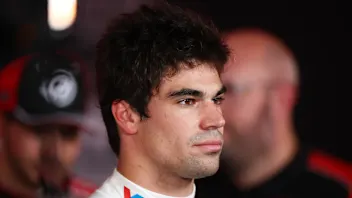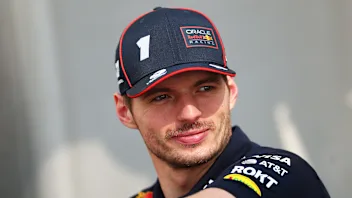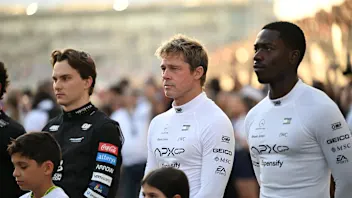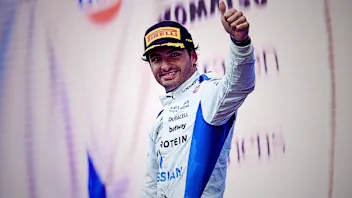Profiled - the men who made Austria's F1® heritage
In celebration of Spielberg hosting a Grand Prix for the first time in over a decade, every living Austrian to have competed in Formula One racing will take to original machinery for a unique legends' parade on Sunday June 22.
From a three-time champion, to a veteran of more than 200 Grands Prix and a man with just one F1 start but who was still competing at Daytona at the age of 73, we profile the nine local heroes set to turn out at this weekend's Formula 1 Grosser Preis von Osterreichring 2014.
Niki Lauda
Active: 1971-1979, 1982-1985
Grand Prix starts: 171
Teams: March, BRM, Ferrari, Brabham, McLaren
Best result: 25 victories (First win: Spain 1974)
Best home result: 1st, 1984
Known as 'the rat' to some of his contemporaries, Niki Lauda is the man who came back from the dead, a straight-talking Austrian and three-time world champion who rose from relative obscurity to restore Ferrari to world championship glory, quit the sport to start his own airline, and then returned to triumph once more.
Lauda was largely dismissed when he bought his way into F1 racing with March in 1971 after an average junior career, but eye-catching performances drew the attention of first BRM and then, in 1974, Ferrari. The Scuderia hadn't won the world championship since 1964, but by his second season Lauda had established himself as a clear team leader and romped to the title.
He was leading again in 1976 before a near-fatal accident at the Nurburgring, after which he was administered the last rites. Remarkably he was back competing barely one month later, but was beaten to the championship by just one point. The following season he was champion once more, winning three times and taking 10 podiums from 17 races, but left for Brabham at the end of the year.
Two seasons later he announced a shock retirement, but he returned for a four-year spell with McLaren which also produced a third and final world championship, this time secured by just half a point - the closest margin in F1 history. He retired for good at the end of 1985, before going on to work with Ferrari, Jaguar and now Mercedes.
Helmut Marko
Active: 1971-1972
Grand Prix starts: 9
Teams: BRM
Best result: 8th (Monaco, 1972)
Best home result: 11th, 1971
Though he grew up alongside compatriot and future world champion Jochen Rindt, it wasn't until after Marko had obtained a doctorate in law that he pursued a full-time career in motorsport. His most notable success came at Le Mans - he won the event with Porsche in 1971, having finished on the podium the previous year.
Formula One racing also beckoned in 1971, with a chance drive in a McLaren run by Jo Bonnier at the German Grand Prix. He failed to qualify, but two weeks later he switched to BRM for his home race at Austria, and he stayed with the team for three further races that season and for the start of the 1972 campaign. Five races in and he put in his best qualifying performance to start sixth at Clermont-Ferrand. He was running strongly too when, on lap nine, a stone kicked up by another car smashed through his visor and flew into his eye. His sight lost, Marko would never compete in Formula One racing again.
His career over, he turned his attention to promoting those of young Austrian drivers. He went on to form the RSM Marko team which became a force in F3 and F3000, ran the Red Bull Junior Team in the latter category, and then became a consultant to Red Bull boss Dietrich Mateschitz.
Dieter Quester
Active: 1974
Grand Prix starts: 1
Teams: Surtees
Best result: 9th (Austria, 1974)
Best home result: 9th, 1974
A race winner in European Formula Two - where he took on the likes of Emerson Fittipaldi, Clay Regazzoni and Carlos Reutemann - Quester's only Formula One outing came on home soil in 1974, driving a Surtees TS16. Quester was the last of the qualifiers - six men missed out - but rose steadily over 54 laps at the Osterreichring and took the chequered flag in ninth, albeit three laps down on the victorious Reutemann.
Quester switched to saloon and endurance racing thereafter, and in 2006 he won the first of back-to-back Dubai 24 Hour titles alongside Hans-Joachim Stuck, Philipp Peter and Toto Wolff, current head of Mercedes-Benz Motorsport. He was still competing in 2013, at the age of 73.
Hans Binder
Active: 1976-1978
Grand Prix starts: 13
Teams: Ensign, Wolf, Surtees, ATS
Best result: 8th (Netherlands, 1977)
Best home result: 12th, 1977
A protege of Helmut Marko, Binder came to prominence when he won the European Formula Ford championship in 1972, which acted as the launching pad for moves into Formula Three, Formula Two and finally F1 racing in 1976. Binder's first outing was at his home Grand Prix, where he qualified his Ensign 19th but retired while running ninth in the closing stages of the race.
He reappeared for the Japan season-finale in a Wolf Williams - again suffering a late retirement - and then raised the budget to join Surtees for the start of the 1977 campaign. When money ran short he made a mid-season switch to ATS, with whom he scored his best Grand Prix result of eighth at Zandvoort. He returned with ATS for a final one-off outing at the Osterreichring in '78, but failed to qualify.
Gerhard Berger
Active: 1984-1997
Grand Prix starts: 210
Teams: ATS, Arrows, Benetton, Ferrari
Best result: Ten victories (First win: Mexico 1986)
Best home result: 7th, 1986
Erratic but also rapid, a veteran of 210 Grand Prix starts over 14 years, Berger had the potential to be the fastest man in the field on his day, despite being up against the likes of Ayrton Senna, Alain Prost and Nigel Mansell.
While his maiden win, for Benetton in Mexico, laid the foundation for future success, it was his final victory that was arguably his most memorable. With his future uncertain, suffering after a sinus operation and dealing with the recent death of his father, Berger dominated at Hockenheim in 1997, taking pole and setting the fastest lap en route to a dominant win.
Alongside such steel, Berger's sense of humour - which often flirted with the macabre - passed into F1 legend. He was the man who threw Senna's briefcase from a helicopter, who filled the Brazilian's hotel room with frogs, and who turned Ron Dennis's air off while scuba diving. When he retired at the end of 1997, the warmth from the paddock spoke volumes for how highly he was regarded. He went on to manage BMW's F1 programme with Williams, took a share in Toro Rosso, and is currently the FIA's Single Seat Commission president.
Karl Wendlinger
Active: 1991-1995
Grand Prix starts: 41
Teams: Leyton House, March, Sauber
Best result: 4th (Canada 1992; Italy 1993; San Marino 1994)
Best home result: N/A
Wendlinger was the second of the Mercedes proteges - alongside Michael Schumacher - placed in Formula One racing in late 1991, and he impressed immediately. After two races with Leyton House, he switched to March for the 1992 season and scored points with a remarkable drive to fourth in Canada, leading to a move to the fledgling Sauber team in 1993. His season finished on a high with top-six results in Hungary, Italy and Portugal, and he carried that form into the following season, scoring in Brazil and San Marino to sit eighth in the drivers' championship after the first three races.
He did not race again that season however: at Monaco, the fourth round, he suffered serious head injuries in a heavy practice crash which left him in a coma for 19 days. He made his comeback with Sauber a year later, but could not assert himself against team mate Heinz-Harald Frentzen and was replaced after four races - but was then recalled for the final rounds, effectively his Formula One swansong.
Wendlinger instead switched to sportscars with notable success, claiming the 1999 FIA GT championship crown and winning the Daytona 24 Hours one year later.
Alexander Wurz
Active: 1997-2007
Grand Prix starts: 69
Teams: Benetton, McLaren, Williams
Best result: 3rd (Great Britain 1997; San Marino 2005; Canada 2007)
Best home result: 5th, 1999
After a relatively unremarkable junior career, Wurz shot to prominence when he won the Le Mans 24 Hours race in 1996. Within a year he had moved into Formula One racing after a chance opening arose at Benetton due to Berger being ill. He seized the opportunity, claiming a podium at Silverstone in what was only his third race.
That helped him earn a permanent seat at the team for the following three seasons. 1998 was particularly strong as he took a series of top-five finishes, with a spirited defence from Michael Schumacher at Monaco among his finest moments.
At the end of 2000 he split with Benetton and joined McLaren as their test driver, a role he occupied for the next five seasons - also finishing on the podium in a one-off appearance for the team in place of the injured Juan Pablo Montoya at Imola. He left to become Williams' test driver for 2006, and impressed enough to be given their second seat for 2007, his final season in Formula One racing. A switch into sportscars and further Le Mans glory followed, with Wurz currently part of Toyota's works LMP1 team.
Patrick Friesacher
Active: 2005
Grand Prix starts: 11
Teams: Minardi
Best result: 6th (USA, 2005)
Best home result: N/A
After four years in F3000 - the first two with the Red Bull Junior Team - Friesacher landed a late deal to move into Formula One racing with Minardi for the 2005 season. He came close to breaking into the top ten in his third race in Bahrain, qualified a strong 13th in Monaco, and then scored his first points in the infamous race at Indianapolis, finishing last of the six cars that contested the Grand Prix. Two races later and budget issues ended up curtailing his Formula One career after just 11 events.
Christian Klien
Active: 2004-2006, 2010
Grand Prix starts: 49
Teams: Jaguar, Red Bull, HRT
Best result: 5th (China, 2005)
Best home result: N/A
Klien laid the foundation for his move into Formula One racing in 2003 - his fifth year in single seaters - as he finished runner-up in the Formula Three Euro Series and triumphed in the F3 Masters at Zandvoort. That, and support from Red Bull boss Dietrich Mateschitz, helped him capture the second seat at Jaguar Racing in 2004, with points coming in both Montreal and Spa.
Red Bull took over the team ahead of the 2005 season and Klien was retained, initially sharing the drive with Vitantonio Liuzzi before taking over full-time. He finished the season strongly with a fifth in China, and kept his seat for what would prove to be his final F1 season in 2006. Leaving midway through the year, Klien landed a test-driver role with Honda's F1 team. He returned to F1 in 2010, contesting three races for HRT, though his main focus has been sportscars, where he still competes.
Gone but not forgotten
Jochen Rindt
A six-time Grand Prix winner and regarded as one of the quickest drivers ever to set foot in an F1 car, Rindt was leading the 1970 world championship when he was killed in a practice crash at Monza. He thankfully remains F1’s only posthumous world champion. For more information, see Rindt’s profile in the Hall of Fame.
Harald Ertl
A journalist and amateur racer, Ertl managed to raise the budget to dabble in F1 competition between 1975 and 1980, contesting 19 Grands Prix and taking a best finish of seventh for Hesketh at Brands Hatch in 1976. Ertl was also one of the four drivers who helped extricate Niki Lauda from his burning Ferrari at the Nurburgring. He was killed in a light plane accident while setting off on holiday with his family.
Jo Gartner
Gartner often ran his own operation as he progressed through the junior ranks, but a superb Formula Two victory at Pau drew the sponsorship to move into F1 racing with Osella in 1984. He scored a strong fifth in only his sixth race, at Monza, but was left without a drive for the following season and moved into sportscars. He was killed in a crash on the Mulsanne Straight at Le Mans in 1986.
Helmuth Koinigg
Koinigg made the move into F1 racing by finding the budget to rent a Brabham for his home Grand Prix in 1974. While he didn’t qualify, he returned for the last two races of the year with Surtees, and captured an impressive 10th in Montreal. His reputation rising, Koinigg was in talks for a 1975 drive when a slow puncture pitched him into a fatal crash in the following round at Watkins Glen.
Roland Ratzenberger
Immensely popular, charismatic and yet self-effacing, Ratzenberger competed in a wide variety of single-seater and sportscar races before moving into F1 racing in 1994 with the fledgling Simtek squad. An impressive 11th place at Aida, in only his second race, would prove to be his only Grand Prix finish - he was fatally injured in a qualifying crash on a tragic weekend at Imola.
Next Up
Related Articles
 Stroll opens up on 'noise' that has followed him in F1
Stroll opens up on 'noise' that has followed him in F1 WATCH: F1 Animated returns for a look back at 2025
WATCH: F1 Animated returns for a look back at 2025 Verstappen reflects on Mercedes talks and F1 future
Verstappen reflects on Mercedes talks and F1 future ExclusiveHow APXGP was brought to life by costume designer Julian Day
ExclusiveHow APXGP was brought to life by costume designer Julian Day ExclusiveWhy Sainz feels ‘vindicated’ after his first Williams year
ExclusiveWhy Sainz feels ‘vindicated’ after his first Williams year.webp) Winners & Losers5 Winners and 5 Losers from the 2025 season
Winners & Losers5 Winners and 5 Losers from the 2025 season